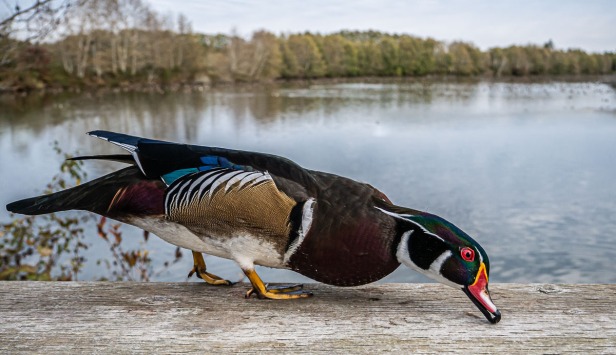

Wildlife surprises you when you least expect it.
Vancouver’s Granville Island is a hub of artists’ ateliers, brew pubs, trendy restaurants, cool boutiques, galleries, and a fabulous market – all nicely spread out in an area that has strictly controlled traffic, and is surrounded by the calm waters of False Creek. There are open spaces, or courtyards, where people hang out, especially in summer and on weekends, entertained by street performers and the activity on the water.
Anyway I’m enjoying the vibe in one of the courtyards when I notice them – hundreds of them – doing a fly by. It’s the pigeons. There are always pigeons there of course. The world over there are pigeons wherever there are people, and especially where people are eating outdoors. But this was something I’d not seen before. There are hundreds of pigeons sitting on the market-building roofs adjacent to the courtyard, and suddenly they all take off. For no apparent reason. As if there is some kind of telepathy, as if they are one being, as if they have one brain. Suddenly they all lift off and fly in a huge circle and land back where they started. After a few minutes they do it again. And again. I’ve not seen anything like it. What does it signify?
Pigeons will eat just about anything! They’ve been called rats with wings. Yeah, they poop a lot, but pigeon waste is no more likely to transmit disease than that of any other animal, and has been used in Turkey as fertilizer for millennia. And they have an understanding of space and time similar to our own; they can be released hundreds of kilometres from home and still find their way back. Smart birds. Homing pigeons. Racing pigeons. If you’re eating one in a fancy restaurant it’s a called a squab. If it’s used as a symbol of peace it’s called a dove. If it’s an urban bird it’s called a pigeon. It’s all in a name; they’re all the same bird, all descended from the rock dove.

In Vancouver there’s a project to limit the number of pigeons in the Skytrain stations by putting in feeders that contain avian birth control. There’s avian birth control? Who knew?
Oooooh donna! Oooooh donna! Oooooh donna! I hear it and my heart rejoices. It’s my favourite birdsong of summer, and when I first begin to hear it in late spring it tells me that, finally, summer is on the way. Without question my favourite birdsong in Australia is the musical warbling of the magpie. In Canada it’s the three-note oooooh donna call of the black-capped chickadee. Chickadees make all kinds of other calls and chirps and tweets, but it’s the high pitched musical oooooh donna that captures my attention. The call is usually heard all summer, but sadly rarely this summer as Vancouver is experiencing the longest dry spell on record. Even the blackberry bushes are wilting. I’m worried for the chickadees.
This shot was taken at Reifel Bird Sanctuary where you can buy birdseed to feed the birds.
I have a friend who hates squirrels because they are rodents. So are capybaras, beavers, hutias, gophers, porcupines, dassies, guinea pigs, gerbils, and marmots. And of course all kinds of rats and mice. The rodent world is wide and deep.
But back to squirrels. Every day I hike a forest trail around a golf course and each time I see one there’s a kind of stopping, looking, connecting, heart-opening at this little fellow-creature who scurries away, or stops to stare, or freezes hoping to be invisible. And then there’s that spring day, in the grasses next to the pond in Jericho Park, when one poses so nicely for me. I get low to the ground and keep still and it obligingly comes closer and closer. A moment of quiet joy. I see you. You see me. Hello.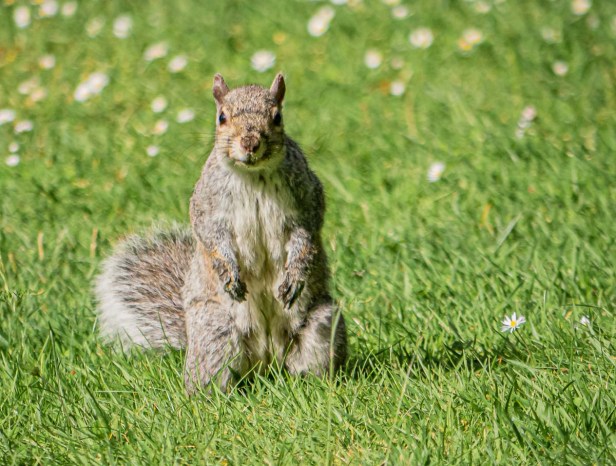

The most common squirrel in Vancouver is the Eastern Grey. The black ones are a melanistic version of the Eastern Grey.
They are not native but that doesn’t seem to have stopped them any. In 1909 a breeding pair was gifted to Vancouver by the mayor of New York and released in Stanley Park. They flourished. They may be rodents but they are a prodigious and essential natural forest regenerator, helping plant distribution by gathering and planting acorns and nuts.
In Stanley Park, deep in the forest on a path not much used, approaching a small faded wooden bridge, I suddenly notice one scurrying by. I stop. It’s a tiny brown/orange squirrel, less that half the size of a grey. I remember I’d seen one a long time before in Lighthouse Park over on the North Shore, a tiny squirrel half hidden in the bush, and didn’t know what it was. Anyway I slowly settle onto the ground and another comes, and another, and another. At least five or six of them. I’m entertained by these tiny creatures for a good fifteen minutes, watching them as they scamper back and forth. It is the relatively rare Douglas Squirrel and I’m lucky enough to have them put on a show for me. They are also called pine squirrels or chickarees. What I call them is cute.
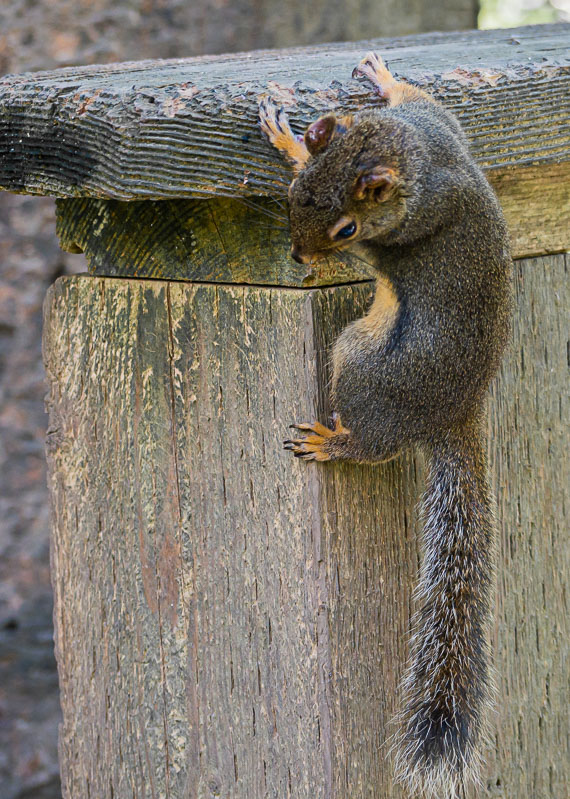
I’ve seen them out at Reifel Bird Sanctuary, down on the Fraser River not far from home, on Stanley Park’s Lost Lagoon and Beaver Lake, and on the lake in VanDusen Garden. And every time I’m both delighted and slightly disappointed. I once saw a Mandarin Duck. What a glorious creature that is! I don’t know if this is an accurate memory or not, but I think it was out at Reifel, so I’m always hoping to see one again. But no, it’s always only the local Wood Ducks. And I’m complaining? Not really. It’s the colours of the male that get me every time. So audacious! Wood Ducks are considered, quite rightly, to be Vancouver’s most beautiful local duck. Its specific Latin name is sponsa meaning “betrothed” or “bride” as if dressed for a wedding, and because in China the Mandarin Duck was formerly given as a marital gift symbolizing fidelity.
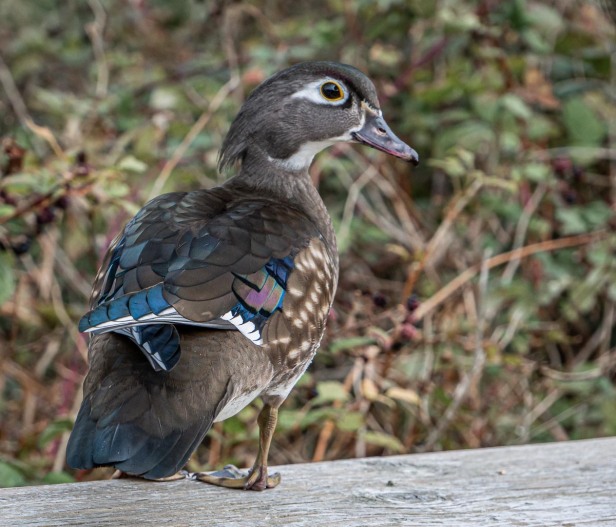
Red-winged Blackbirds are found all over the US and Canada; these little birds know how to get around. They breed mostly in fresh water marshes, swamps, and rank weedy fields. Clearly they are not too fussy. Females stay low, skulking through vegetation for food and quietly weaving together their nests, which is probably why I’ve never seen one. Also they’re mostly boring brown. The males are a glossy black with their signature red-and-yellow epaulettes, and will do anything to get noticed. I notice them! The ones out at Reifel Bird Sanctuary are so tame they’ll eat out of your hand.
At just about every park in Vancouver there are faded signs with instructions for what to do if you encounter a coyote. There are between two and three thousand of them here. And yet I’d never seen one. I had no idea there were so many here, and I thought the signs were out of date and they’d just never bothered to take them down.
We moved into our current apartment four years ago and almost every day walk a forested trail around a local golf course. Suddenly one day I see one on the golf course! It’s such an exciting moment. For the next two years I see one every couple of months or so, but of course can never get close. Then one day, in a stunningly unusual and serendipitous move, I decide to take my camera with me on my daily hike. And all but walk into a coyote on the street!

It had come out of the bush to cross the street and eat the berries that had fallen on the ground from a tree in front of a house. I’m spellbound! Finally I get to see a coyote up close. It’s the only one I see for the next two years and I assume the B.C. Conservation Service has rounded them up and removed them. Then just a couple of weeks ago I see one, again on the golf course, walking nonchalantly across a putting green and into the forest.
They have a part to play. Like any port city there are rats in Vancouver and the coyotes are a major rodent predator. On the other had, just recently, they’ve been attacking people in Stanley Park: more than thirty people in the last six months, and four coyotes have been euthanized. They arrived in Vancouver in the 1980’s and from then until late last year there have been only eight recorded attacks. The reasons behind the increased aggression is not known, but could be related to increased use of the park because of the pandemic. Perhaps those signs are needed after all.
Fishermen in Alaska used to hunt Bald Eagles. The local eagles would return to Alaska every year for the annual salmon run and the fishermen believed they were a threat to their catch. Meanwhile the decline of this west coast eagle was exacerbated by the use of DDT. Since DDT has been banned, and it became illegal to hunt them in the US, Vancouver’s population of Bald Eagles has rebounded from a low of only two nests in the 1960’s. Now there have been up to twenty nests spread across Vancouver with as many as fourteen in use, including several in Stanley Park.
The Bald Eagle is one of the most unorthodox creatures to call Vancouver home, but food is the likely reason they stay. Massive flocks can be seen at the Vancouver Landfill feasting on organic scraps. Clearly they have adapted well to an urban environment. Humans are a problem for every species, so when creatures like the Bald Eagle find a way to adapt it’s always encouraging. And no matter how many there are it’s always a heart-stopping moment to see one. Look! An eagle! we’ll cry. Every time. Unless Don’s driving. Then I keep my mouth shut.
Worldwide there are about 48 million of them! Preferring calm shallow fresh water they have adapted well to life in the city, occupying just about every pond and stream in every park. They are mallards, the best known wild duck in the world, and they are everywhere. They are probably the first wildlife a small child is introduced to. Was there ever a more timeless activity than feeding the ducks? They are the ancestors of many breeds of domestic ducks. And they are famous as a game bird and extensively hunted, yet still they thrive.
They gather in flocks, and then pair up during breeding season. Every spring there are dozens of new ducklings in every pond and stream in the Vancouver area.
They are as ubiquitous as the Canada Geese. From time to time I experience them with the boredom or the dismissal that comes with extreme familiarity. There’s nothing exotic about them. Where are the Mandarin Ducks dammit? And then I drop into their world, open to them, and see there’s nothing boring about them at all. They are so much themselves. They swim, they turn upside down in the water to feed on underwater plants, they hissing-chase each other out of their territory, they quack and flap their wings, and they waddle on land with the little ones following. When I take the time to see it, the mallards really put on a show.
The females have a practical camouflage of brown plumage,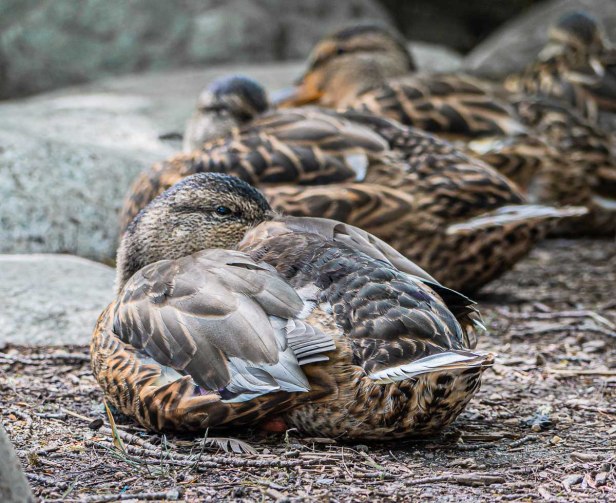


and the males of course have all the colours – the magnificent iridescent green/blue/purple head and neck, and the bright yellow bill, all the better to attract a mate. After breeding season, their glorious plumage fades to brown, no longer of use.

I can hardly believe it! Randomly I lean over the pier railing to look down at the swampy bank of the river below and there’s a beaver there!

I’ve lived in Canada for over thirty years, much of that spent cooking in wilderness camps, and this is my first ever beaver sighting. I am beyond excited, and watch it for several minutes as it munches on the grassy stalks and then waddles back into the river and out of sight.
Okay I lied. Don and I spend a lot of time down at the Fraser River in the summer, and once, one evening, I saw a beaver stick it’s head up out of the water for a split second and them dive back under again. It hardly counts as a real sighting. But that time on the pier was the real thing.
And then only a month later we’re in Jericho Park and decide to walk across the bridge over the end of the pond and there is a whole beaver performance going on there! There are two adults, and three kits,
swimming back and forth, grooming,
and eating.
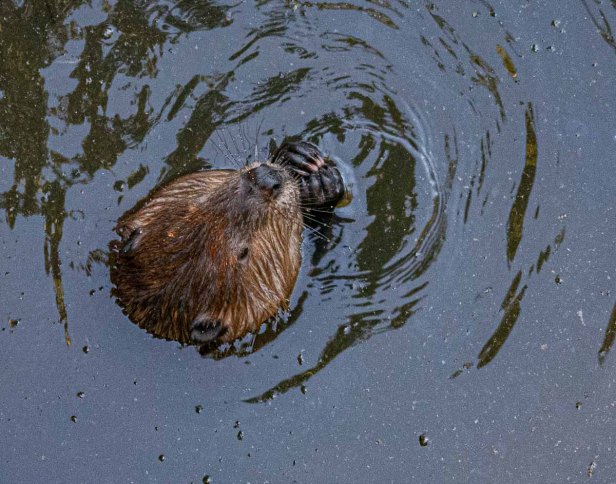
We can see the lodge (which seems to get bigger and bigger every year), and we see one of the adults bringing more branches for it. We’ve been given a glimpse into their world. Of course I wish it were possible to put a webcam inside the lodge. That would be something to see!
They use their tails as a rudder, and for balance and support when gnawing down and dragging trees to build the lodge, and as a warning when disturbed by slapping it repeatedly on the water. It’s really loud! And here’s a few more factoids to show just how remarkable nature is: beavers have valves that close off the ears and nostrils, skin flaps that seal off the mouth but leave the incisors free for underwater gnawing and carrying, and clear membranes that slide over the eyes protecting them from floating debris.
The BC Conservation Service removes the kits to the wilderness when they’re old enough as the park pond couldn’t sustain an ever-growing community.
I can’t do a post about Vancouver urban wildlife and not mention bears although I’ve never seen one here (though I did see quite a few when I was cooking in those wilderness camps). If you live on the upper heights of the North Shore it’s likely you’ve seen plenty. There is a clear demarkation line between urban development and untouched wilderness. On one side is housing, on the other endless forest. The bears wander in for food. There’s a whole protocol for putting out garbage if you live in that part of town. A conservation officer was once asked why they couldn’t design a truly bear-proof garbage bin and the reply was that there is considerable overlap between the smartest bear and the dumbest human.
I know I wrote about Canada Geese in the previous post about Vancouver urban wildlife, but still must share a photo which I took this spring – the newest generation, a very young gosling in the grasses at Jericho park.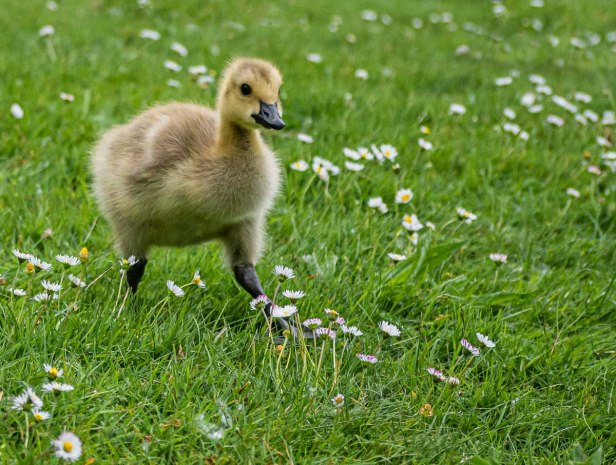
PS In researching this post I have discovered there is a Mandarin Duck living out in Burnaby Lake Park! We will be going there very soon. Hopefully tomorrow. Hopefully I’ll update with a photo.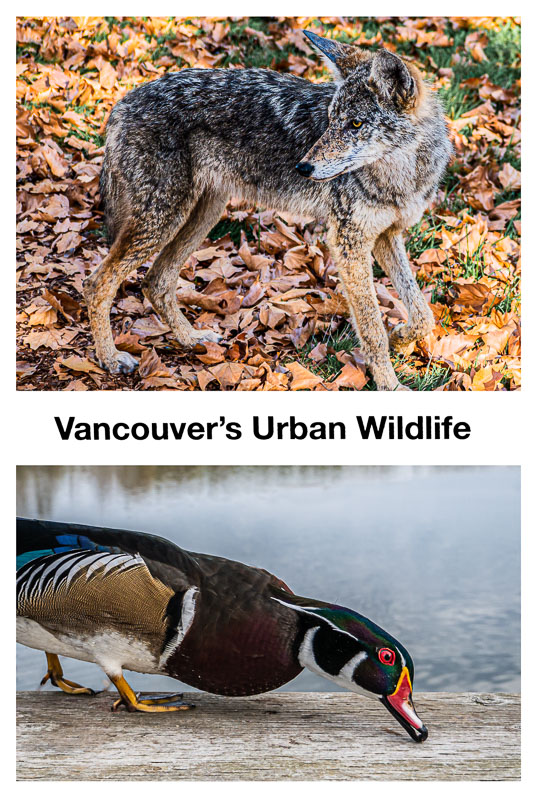
Next post: a solo travel adventure to the fishing village of Steveston.
All words and images by Alison Louise Armstrong unless otherwise noted
© Alison Louise Armstrong and Adventures in Wonderland – a pilgrimage of the heart, 2010-2021.

I love the critters and the bird being fed with the open wings so cool…I didn’t know coyotes were there in the 80’s…fun post…so much to see and do in Vancouver 🤓❣️🌞 hugs hedy 💫
LikeLiked by 1 person
Thanks so much Hedy. Reifel is quite amazing – we always see cool stuff there, and always buy the bird feed – so much fun having them eat out of your hand, or having a whole flock of mallards flying at you because they know you have food. Got some ok pics of that but didn’t really have a high enough shutter speed. Next time.
Alison
LikeLike
How wonderful! Love them all. Beavers used to live here when I was a child. Now they are no more. I miss them. I see coyotes constantly. We have packs and packs of them. Super intelligent critters, that share lots of wolf DNA.
LikeLiked by 1 person
Thanks so much Cindy. It was so exciting for me to see coyotes and beavers. Perhaps not for Canadians, but coming from Oz they are still quite exotic for me. Even so, I’ve seen dozens of kangaroos and I’m still not blasé about them!
I was amazed to learn there are 2-3 thousand coyotes in Vancouver. It’s a wonder it took so long for me to see one. Not surprised to hear they share wolf DNA.
Alison
LikeLike
I love them all
LikeLiked by 1 person
Thanks so much Beth. I do too 😊
Alison
LikeLiked by 1 person
What a lovely way to begin my day, walking along with you and enjoying your photos!
LikeLiked by 1 person
Thanks so much Anita. I’m glad you enjoyed it. Nothing like a little nature to brighten a day. Nice to see you here again!
Alison ❤️
LikeLike
Gorgeous photos, Alison. I guess I’m not so surprised about the coyotes. They are everywhere now. I hear them at night. The attacks are no surprise either. They are ruthless. I hope you get to see and photograph a bear one day. I have yet to see one, as well, though they are definitely around.
LikeLiked by 1 person
Thank you so much Julie. I was amazed to hear there are so many coyotes here. I’m sure the attacks are because of a combination of people feeding them (so stupid) and much more activity in the park since covid lockdowns. People ventured into the forested centre in the centre of the park in far greater numbers than usual.
I do hope to be able to photograph bears one day. We’re vaguely toying with a trip to see the salmon run one year. Don watches a webcam (Kitimat I think) of the salmon run happening right now and there are always bears there, up to a dozen or more! That would be something to see!
Alison
LikeLiked by 1 person
What a great range of animals! I can’t wait to see my first beaver! That’s really cool the bird sanctuary lets you feed the birds too. I’m taking a wildlife rehab course and did you know that squirrels have the highest mortality rate at rehab centres due to improper handling by the public?
LikeLiked by 1 person
There’s so much wildlife here! I just love it. Eventually you’ll see a beaver. It only too me 35 years 😂 😂
The bird sanctuary is for migratory birds, and the birdseed is for the locals that stay year round – Canada geese, mallards, chickadees, blackbirds. It’s fun to be able to feed them.
I did not know that about squirrels. Is it from people trying to keep them as pets, or feeding them the wrong stuff, of not knowing how to deal with an injured one? I know a person who feeds peanuts to one but is not trying to make a pet of it, oh and some other people in Montreal that leave nuts out for them.
Alison
LikeLike
Well, I am keeping my eyes peeled for beavers any time I am by the river. With the squirrels, it’s mainly that people keep thinking baby squirrels are abandoned. There are too many instances where people think animals have to helicopter parent, just like they do. Although, improper handling is a factor as well with the squirrels
LikeLiked by 1 person
Beavers are best seen at dusk. Also find out if there’s a lodge (or dam, same thing) somewhere in a river/pond/lake – if you can actually see the lodge and go there late afternoon your chances of seeing one go way up.
LikeLike
Thank you! 😊
LikeLiked by 1 person
Beautiful photography.
LikeLiked by 1 person
Thanks so much Dani.
Alison
LikeLiked by 1 person
How lovely! When I learned about the Mandarin duck as well as its equally flamboyant underwater counterpart — the mandarinfish — I was reminded of how crazy Mother Nature can be when it comes to coloration in animals. They are just stunning! Now let’s talk about those cute squirrels. I don’t know why, but I always love them. Whenever I see one on a tree here in Jakarta, I feel like a kid who sees this fluffy rodent for the first time. And when I saw them every where in Sri Lanka, it made me happy. It’s amazing how much wildlife you can see right on your doorstep, Alison!
LikeLiked by 1 person
I love the colours in nature! I had to look up the mandarin fish. Wow! Wow wow! It’s amazing. I hope to see one IRL one day. Stunning indeed!
I too love the squirrels – so cute. They make me happy too.
Vancouver’s fabulous for wildlife. I know you’re going to get here one day!
Alison
LikeLiked by 1 person
Some incredible pictures in here! I used to love squirrels – until we moved into this house and my partner has been chewed out by the local squirrel several times. Also the same one that’s eating our sunflower heads.
Love the pictures of your friends, though. 😀
LikeLiked by 1 person
Thanks so much Felicity. Oh that sounds horrible with the squirrels. I must admit I’m curious to know what you mean that your partner was chewed out by a squirrel. Did it bite him? Maybe it expects you to feed it. 😂
So sad about the sunflowers 🌻 that would make me mad too.
Alison
LikeLike
What a beautiful post. Your photos are stunning as usual but the one of the chickadee with its outstretched wings feeding from Don’s (?) hand is remarkable. They may be rodents, but I’ve always loved squirrels, and like you I can’t help but cry “Look! An Eagle!” every time I spot one of those magnificent birds. The coyote situation in Stanley Park is sad, both for the animals and the people who got injured. I’m sure the increased number of people in the park plays a role and perhaps, with that, the increased access to human food and garbage. I see them quite often in our neighbourhood—always a thrill and they’ve always run away quickly.
LikeLiked by 1 person
Thanks so much Caroline. I admit I had to be a little patient to get the chickadee shot, and like with all my photography I took many before getting the right one.
I love the squirrels. Well most beings of the natural world are a source of joy and wonder for me, plus they’re cute! And the eagles are always magnificent – a symbol of freedom and power I guess.
It is sad about the coyotes. I hope the situation settles down. Eight attacks in about 40 years, then 30 in the last 6 months – I can only think it’s the increased use of the park that has done it. If the coyotes come to associate people with food it’s not surprising they’d try to get it (like the monkeys in India and SE Asia). And I went on a little hike right into the middle of Stanley Park a few weeks back without knowing anything about it! Lucky. Even so it’s still a thrill for me too to see one where I live – a long way from Stanley Park!
Alison
LikeLike
I got a few dozens pigeons. They are living on my balcony. If I feed them they never want to leave, pooping drops create a lot of dirt. If I drive them they come back again and again in the hope of foods. I love those but my neighbors, who always complain. Please give a solution how to drive them. Petro
LikeLiked by 1 person
I can’t help you Petro. I don’t know much about it. But for sure don’t feed them. Maybe they will eventually get the message and go away if there’s no food.
Alison
LikeLike
What a cute and beautiful collection of photos!
LikeLiked by 1 person
Thanks rabirius. The local wildlife is for sure one of the things that makes Vancouver so special for me.
Alison
LikeLike
Maybe those pigeons staged a murmuration? 🙂 I love how you’ve presented critters we usually think are mundane, such as pigeons and squirrels, and turned them into art with your beautiful photography. And that Mandarin duck is exquisite!
LikeLiked by 1 person
Thanks so much Susan. I guess I just love pretty much all critters, even if they are mundane, and just as much love to photograph them. (There may be other critters but they’re not included because I didn’t get a good enough photo – she whispers.)
Isn’t the mandarin duck an extraordinary thing?!
I do like your idea that the fly-by was a pigeon version of a murmuration!
Alison
LikeLike
Listening to your conversation about Stanley Park on the podcast was a good introduction to this post. 😉 I love the Wood duck – they’re such a treat to see. Black-capped chickadees have been a staple in my life since early childhood on the east coast but I’ve never seen their call transcribed that way – interesting! We have Chestnut-backed chickadees here, too, and I bet you could find them in the park. Even smaller! Your Mallard photos are beautiful…here’s to nature in the city!
LikeLiked by 1 person
Thanks so much Lynn. Stanley Park is such an amazing place, especially being in such a huge city. Almost all of it is protected forest and so much lives in there. Too many people wandering into the centre during the pandemic, plus idiot people feeding the coyotes – I guess something had to give. But it’s a really special place, and we’re very lucky to have it.
The wood ducks are a treat. I still haven’t been to Burnaby Lake to look for the Mandarin duck. One of these days . . . .
I got the “Oh Donna” from a friend. I’d never thought of it that way before I heard it from her. https://www.youtube.com/watch?v=LfMsUuU9KtQ On this video they call it “Hey sweetie”.
Alison
LikeLike
Always enjoy your blog. Thank you.
The title is: “Part 2”, I looked all over for “Part 1”, is there a Part 1?
Thanks again.
LikeLiked by 1 person
Thank you so much. I’m glad you’re enjoying the blog.
So sorry! I didn’t label it part 1! Anyway here it is:
LikeLike
Thank you so much.
Love your photographs!
LikeLiked by 1 person
Thank you.
LikeLike
Every city should make urban forestry a priority. Love how Vancouver has allowed wildlife to prosper. Thank you for sharing.
LikeLiked by 1 person
My pleasure James. For sure the abundance of wildlife and wild places is one of the big reasons I love Vancouver so much. And I agree that urban forestry should be a priority. We are very lucky here.
Alison
LikeLike
Wonderful post and fantastic photography!! Bravo!
LikeLiked by 1 person
Thanks so much Susan. I’m glad you enjoyed it. We’re so lucky with all the wildlife here. I just love it. I was out a couple of days ago taking (yet more!) photos of Canada geese as the munched their way across the big green lawn in the middle of the athletic track. Fun, They are everywhere.
Alison
LikeLike